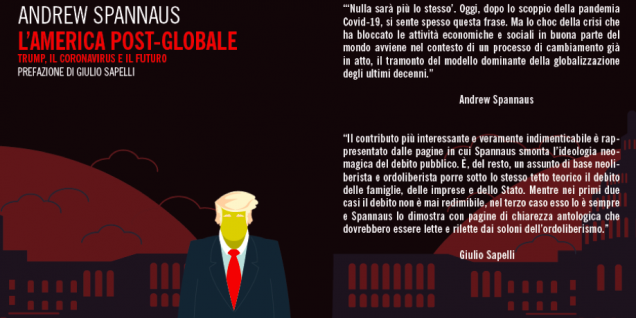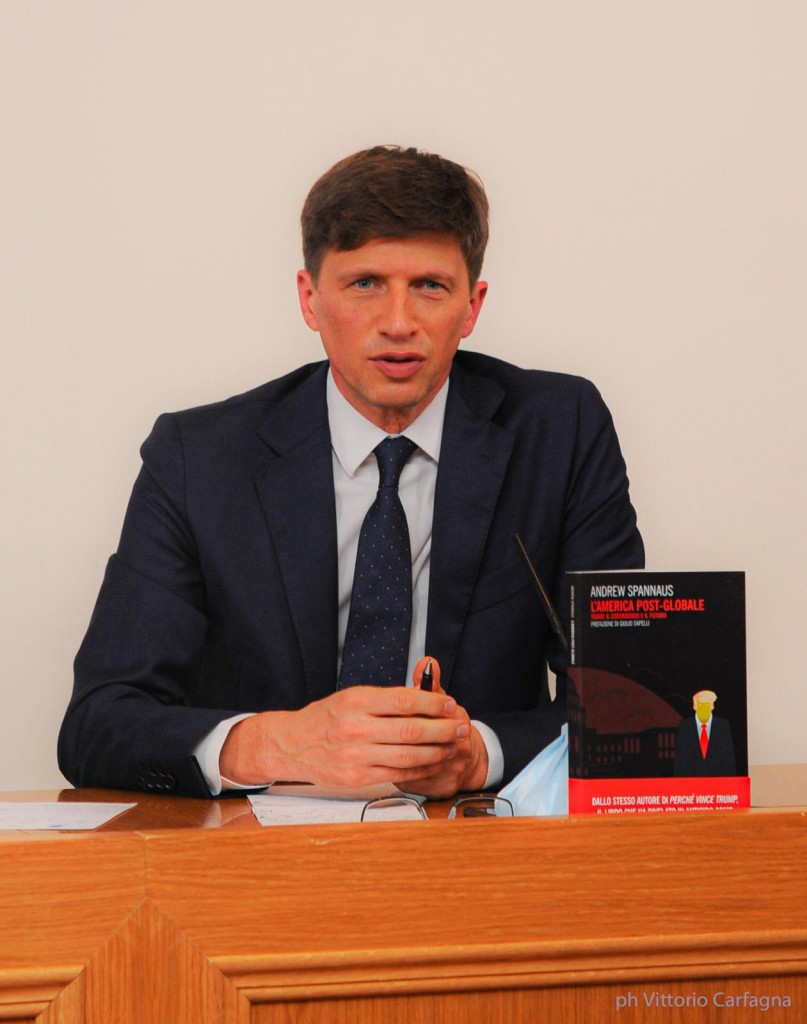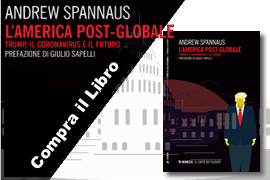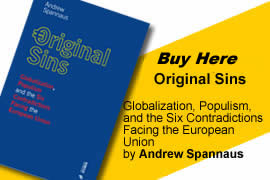The United States – and indeed the entire Western world – is undergoing a shift in regard to the policies of globalization, that will lead to a new direction in economic and foreign policy in the coming years. In his four years in office, despite his obvious faults, Donald Trump has inaugurated a number of changes that will accelerate the transition away from the deleterious trade policies of the past decades, legitimized a return of “industrial policy,” and stressed the need for a new realism in regard to foreign wars and the rise of China. The result of this period of disruption, consisting of both successes and failures, is a new political climate that, however unsettled and divided, allows for recognition of the errors of recent years, and the use of new tools to address the economic and strategic challenges of the coming period.
This is the thesis presented by journalist and political analyst Andrew Spannaus in his Italian-language book on “Post-Global America” (L’America post-globale. Trump, il coronavirus e il futuro, Mimesis, September 2020), which reviews Donald Trump’s term as president, and assesses how the combination of this period of “populist” policies and the explosion of the Covid-19 pandemic will shape policy in areas ranging from state intervention in the economy and the role of central banks, to trade deals and strategic competition with China. The book has been the subject of numerous presentations in Italy in recent months, most notably an Oct. 6 public event at the Foreign Press Association in Rome with former Italian Prime Minister Massimo D’Alema and deputy federal secretary of the Lega party Giancarlo Giorgetti.
(Germano Dottori, Angelo Polimeno Bottai, Massimo D’Alema, Giancarlo Giorgetti, Andrew Spannaus)
The first part of the book analyzes Trump’s clash with the political and media institutions of Washington, to set the stage for the president’s pursuit of the two goals that cemented his status as an outsider willing to challenge the establishment: the defense of American industry against globalization, and the abandonment of the never-ending regime change wars which have cost both trillions of dollars and many thousands of lives. These are in fact aims that most of the U.S. population supports, whether they are proposed by the left or the right.
Spannaus takes a realistic view in assessing what progress has been made on these two major issues, that have driven the emergence of populist movements across the West. His answer is that Trump has shifted the conversation considerably from five years ago: by now almost nobody questions the need to combat the post-industrial decline of the United States and the increasing inequality it has bred, and the political pressure against foreign military intervention has forced Washington institutions to adjust their rhetoric across the spectrum.
At the same time, the contradictions in Trump’s actions are clear: while he deserves recognition for being the first president in 40 years not to have launched a new war, there are other areas where he has hewed closer to the line of traditional interventionists, with economic warfare, targeted killings, and neo-conservative rhetoric. On the economic front, the immediate effects of Trump’s policy shifts have so far been limited, even before the failure to manage the Covid-19 crisis: manufacturing stalled after an initial uptick, insecure working conditions and low wages are still widespread, and the president quickly gave up on his promise to spur sustainable economic growth with large-scale investment in infrastructure.
Yet new momentum has been generated to address these problems, and significant shifts have begun in economic policy during Trump’s term, for example on trade deals, and the nature of government intervention during the initial months of the 2020 pandemic. Concentrating on the renegotiation of NAFTA, which led to the bipartisan passage of the United States-Mexico-Canada Agreement (USMCA), Spannaus identifies an inflection point in trade policy. An important change in direction has occurred, away from a shareholder value-driven approach of prioritizing low costs, at the expense of socio-economic conditions in the United States and workers’ rights and well-being in developing countries; the negative impact on economic resilience and national security of far-flung global supply chains has also become painfully clear during the Covid-19 pandemic.
In his introduction to the book, Giulio Sapelli, a well-known professor of economic history whose name has been floated for the post of prime minister in recent years, extols the “unforgettable pages in which Spannaus dismantles the neo-magical ideology of public debt,” urging that they be “read and re-read by the Solons of ordoliberalism,” referring to the German strain of thinking that has heavily influenced the European Union’s strict rules on public spending. Indeed, this year the United States and other countries have demonstrated that in the midst of a grave crisis the government can and must spend massively, while any fears of a debt crisis can be dispelled by the proper use of central banks to cover bond issues and manage interest rates.
By way of example, consider the spending packages approved by the U.S. Congress, amounting to approximately 14% of GDP in just two months at the start of the pandemic crisis. Worries about the debt were set aside, and rightly so, since the myth of the country’s finances being at the mercy of private lenders or foreign countries is just that: China holds only 4% of U.S. public debt, while about 40% is held by the Fed and various government agencies and funds. And the portion held by the Fed has increased, as it has bought new bonds issued by the government to finance the economic stimulus (while ultimately returning any interest payments to the government itself). This, along with loans finally made directly to productive businesses, is a much better use of the Fed’s powers than seen in the past, for two reasons: first, because for years the Fed provided massive amounts of liquidity to only the financial sector, bailing out banks and funds as the rest of the economy collapsed; and second, because it was responding to directives from the Department of the Treasury, thus making the central bank a tool of government policy, rather than merely an independent entity that for too long has fed the cycle of financial speculation and rising inequality affecting the middle and lower classes.
The argument in favor of abandoning the notion that public spending always represents borrowing to be repaid, or that funds need to be raised principally through higher taxes, is bolstered by the historical data Spannaus uses regarding public debt. After a brief look at the approach to debt in American history, the author reports that for the past 62 years, without interruption, the absolute level of public debt has continued to increase. The amounts spent in the 1960s on important investments such as the space program were never paid back directly, but they provoked tremendous economic growth, such that managing the debt hasn’t been a problem. The percentage of debt-to-GDP varies depending on the level of economic growth, but today even this measure is beginning to be considered obsolete: economists such as Larry Summers and Jason Furman, who by their own admission had very different views in the past, are now arguing that levels of public debt should no longer be the guide for how much spending the government can sustain, given the primary need to support economic growth.
That’s not to trust practitioners of neoliberalism who are open to more spending today, but could just as easily call for austerity again tomorrow. There are more serious views in the academic world, such as those of professors Stephanie Kelton and James Galbraith, who argue that deficits are not a burden, but a necessity to increase economic activity. Spannaus takes a page from American history to go even further, citing the Legal Tender Act of 1862 which gave the government the power to begin printing “greenbacks” without any basis in gold or silver: public debt is just a number, and when policy is used properly to ensure the creation of real wealth in the private economy, avoiding excessive liquidity or speculative operations that will translate into inflation, money can be generated as necessary without needing to create a debt towards anyone, thus removing the specious arguments of recent years on why there are never enough resources for economic investment.
In Post-Global America, Spannaus argues that the cat is out of the bag: it is now clear to most that the fictitious constraints of the budget deficit should not hinder the need to tackle the major questions facing the country, such as infrastructure, technology investment, and the social safety net. The outcome of the Nov. 3 election will certainly put this thesis to the test, given the Democrats’ minimal majorities in Congress; in fact, many are already seeking to put the brakes on further spending. The importance of the shift has in fact not been lost on traditional Republicans: consider the move by Sen. Pat Toomey of Pennsylvania in mid-December to roll back the expanded lending powers granted to the Federal Reserve earlier this year. Toomey temporarily blocked the latest urgent economic relief bill in an attempt to prevent the Fed from being able to intervene directly in the economy in the future. His justification? That the Fed’s programs could be used as an “instrument of fiscal policy, which is a terrible idea.”
It’s a terrible idea, that is, if you think that the powers of government should be constrained by fear-mongering about the deficit, without the possibility to use the resources of the central bank to intervene in any areas beyond monetary adjustment, where it has proven particularly adept at fueling asset bubbles, facilitating increasing inequality and draining resources from the productive economy. The reality is that the entire framework underlying fiscal conservatism risks crumbling, subtracting considerable power from those who wish to use worries about the public debt to shape political priorities.
There are other important areas where the shift away from the policies of globalization is manifest: for example the push for re-shoring, i.e. the shortening of supply chains with the return of certain types of production to the United States from low-cost countries, coupled with the revival of calls to “Buy American.” What may have sounded like “nationalism” – for years treated as a bad word reeking of racism – now permeates both sides of the political spectrum, and the center as well. Bernie Sanders has said for years that “the era of outsourcing is over,” while Elizabeth Warren published a plan for “economic patriotism” during the 2020 Democratic primaries. And President-elect Joe Biden isn’t far behind: read his economic proposals and you’ll find that the basic goals are not much different than those of Donald Trump.
At the same time, calls for a departure from free-market fundamentalism have been growing in the Republican Party as well, for example from American Compass, a group founded by people close to Marco Rubio – who in recent years has been promoting his idea of “common-good capitalism” – and even Mitt Romney, along with other conservatives who have left free-market think tanks such as the Heritage Foundation and the Manhattan Institute. The website also includes references to great “American System” thinkers such as Alexander Hamilton, Henry Clay, and Friedrich List.
A foretaste of the potential for a left-right alliance in favor of greater government economic intervention, shrinking the power of the “fiscal responsibility” faction, came in mid-December when Senator Josh Hawley, a conservative from Missouri, paired with Sen. Bernie Sanders to demand the inclusion of a new round of stimulus checks in the latest economic relief bill. The effort was dismissed by some as doomed to fail, but the pressure brought to bear led to an agreement to include new payments, albeit at a lower level than in April; President Trump ended up demanding the amount of the checks be raised even further, although his insistence risked blocking immediate implementation of the urgent bill.
There is no guarantee that this policy orientation will become dominant in the near future, but the general direction is clear; the bell is tolling for neoliberalism, and the policies of globalization that have produced an economic, social, and political crisis that can no longer be ignored. For years elites have scoffed at the effects on the middle class, but now there is a strategic factor that is forcing the United States, and the West as a whole, to take its problems more seriously: the rise of China. This is another area where the change during the Trump years will be permanent: the U.S. institutions have abandoned the notion that economic ties with China will lead to democratization, and that Beijing will soon be considered a “responsible global actor” by Washington. A period of great power competition has begun, which requires the West to rebuild its economic strength and alliances, without the short-cuts sought through decades of dominance of global financial institutions. A key area of this challenge will be to make large investments allowing for a leap forward in digital technologies, given their extensive implications for both economics and strategy. Reality has overtaken the political illusions of the past on numerous fronts, forcing the United States to scramble to make up for its errors, in a world that will increasingly be post-global.









January 4, 2021
English, Notizie, Politica, Strategia